Ducks are designed to withstand cold weather; however, being cold-hardy doesn’t necessarily mean that ducks can survive sub-zero temperatures, though. Their body design can only help so much to protect them against severely cold weather.
Freezing weather can kill ducks if they don’t have access to any shelter or food sources. While wild ducks try to escape brutal, freezing weather or fend for themselves finding shelter and food, backyard ducks need help staying warm when the weather turns.
If you live in areas that get cold, you can invest in cold-weather duck breeds and know that you can help them stay comfortable year-round. Even duck breeds that are well suited for cold weather rely on their owners for further protection. Here are 12 of the best cold weather duck breeds to consider owning if your climate gets cold each year.

The 12 Cold Weather Duck Breeds
1. Muscovy

Muscovy ducks are large, weighing 8–16 pounds. They are used as dual-purpose ducks for egg and meat production, although they produce much more meat than eggs. On average, these ducks lay between 60–120 eggs per year.
Muscovy ducks have dark brown or black feathers mixed with white. They also have red or pale caruncles, or fleshy masks, on their faces. These caruncles can get frostbitten in severely cold weather. Special attention should be given to this breed in extreme cold. However, their large, muscular bodies do well to protect them from being uncomfortable when the temperature drops.
Muscovy ducks are friendly but don’t like to be held or picked up. They’re quiet ducks that make good pets.
2. American Pekin
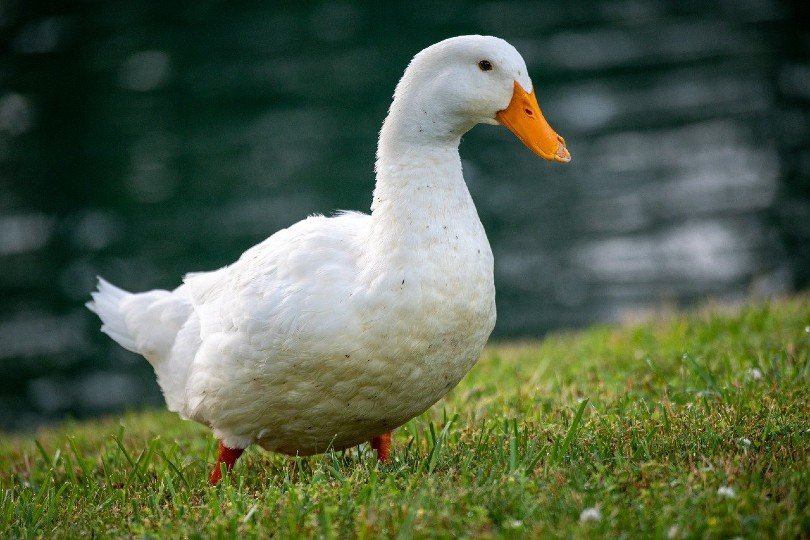
The American Pekin duck was brought to the United States from China in the 19th century. They have large, solid bodies, weighing 8–11 pounds. This breed is primarily used for meat, but they can lay over 150 eggs each year. They continue to lay eggs during the winter. Their size equips them to withstand cold weather.
American Pekin ducks are born yellow and turn white as they mature. Their bills are deep yellow. In addition to being able to survive long, cold winters, they also have impressive immune systems.
3. Cayuga
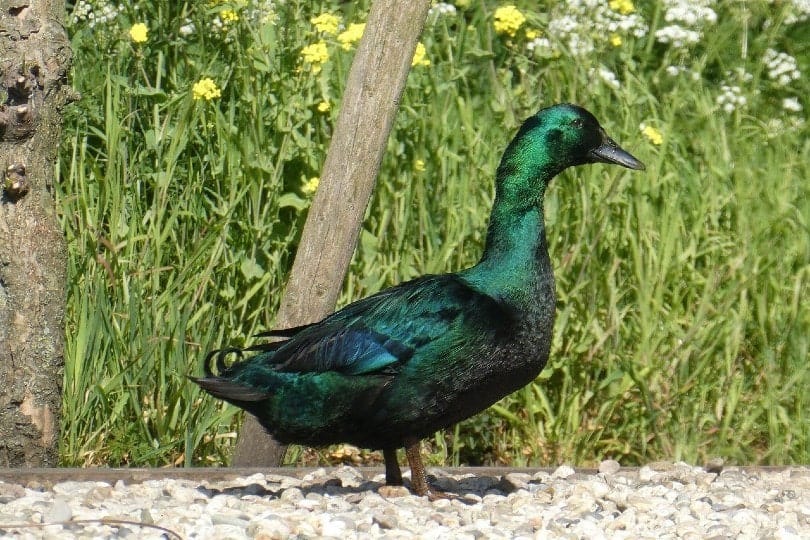
The Cayuga duck is an American breed with pure black feathers due to a genetic mutation. The black feathers can have an iridescent green or blue sheen to them in the sunlight. They weigh around 8 pounds as adults. While these ducks can be kept for meat or eggs, they are most often kept as ornamental pets because of their rare coloring. They are also social birds that are easy to tame.
Cayuga ducks can survive harsh winters and are a popular choice for homesteaders who live in colder climates.
4. Welsh Harlequin
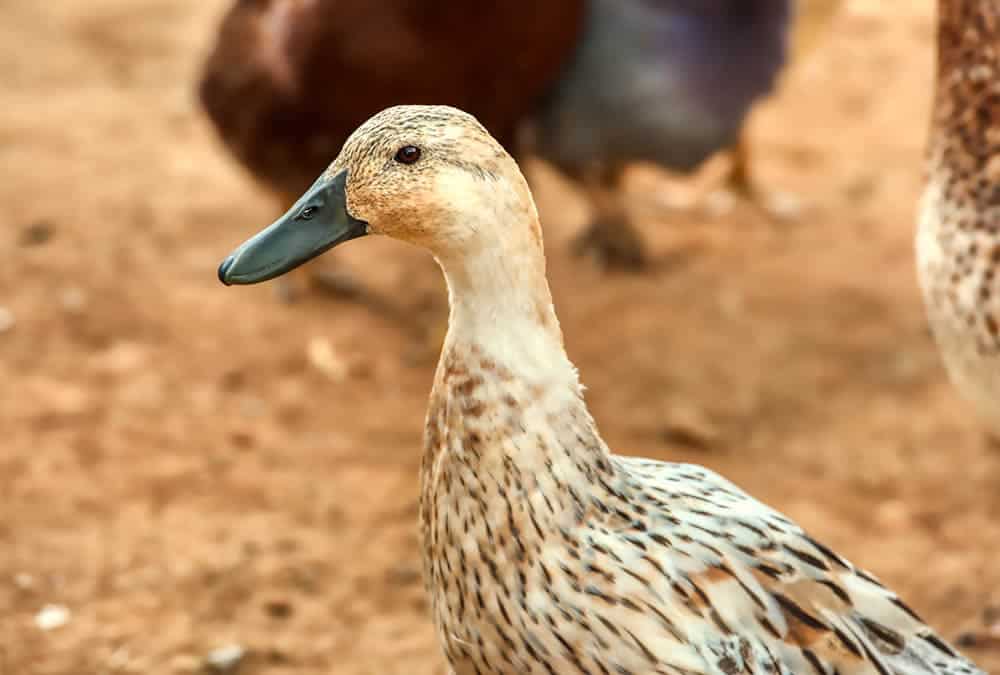
Welsh Harlequin ducks were created in Wales in 1949, making them a relatively new breed. A genetic color mutation was discovered in newly hatched Khaki Campbell ducklings. From there, these ducklings were bred exclusively to establish the mutation and create the Welsh Harlequin breed.
These ducks have long bodies with rounded chests. They have coloring like Mallard ducks, but their feathers are marked with white. They have greenish-black heads, reddish-brown and white bodies, and shiny green and bronze crossbanded wings.
Welsh Harlequins are tolerant of various weather conditions, from cold to hot or those that change frequently. They are dual-purpose birds but are mostly kept for their egg production. They can lay eggs all year round, producing as many as 300 in a year.
5. Indian Runner
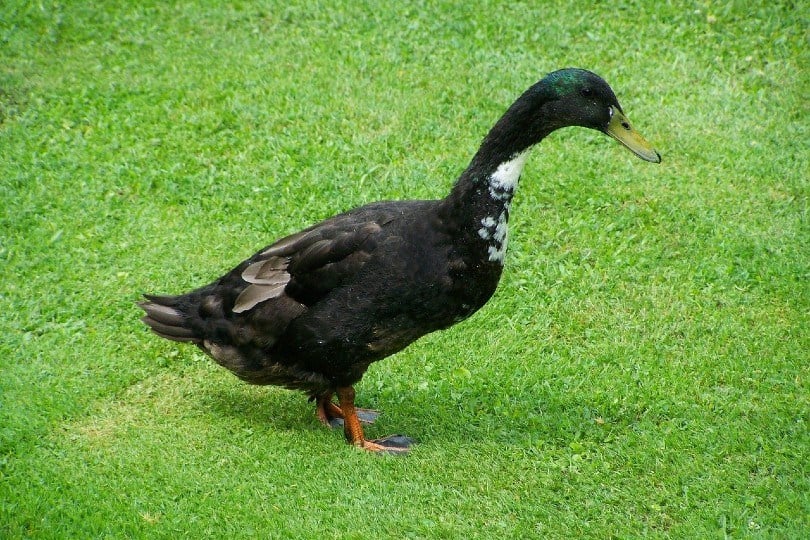
Indian Runner ducks are easy to keep in all kinds of weather. They not only tolerate but also seem to enjoy cold weather. They will choose to stay outside in the snow for long periods. They’re flock birds that prefer to stay together in groups.
Indian Runner ducks are primarily kept for eggs, producing about 300 per year. These are small ducks that weigh between 3–5 pounds. They can be used for meat but won’t produce as much of it as some other breeds.
These ducks make great pets and are entertaining to watch. They stand erect like penguins and run rather than waddle. They don’t fly and they normally don’t build nests. If these ducks are used for egg production, they will need to be housed at night, or else they will lay eggs wherever they please outdoors.
6. Call
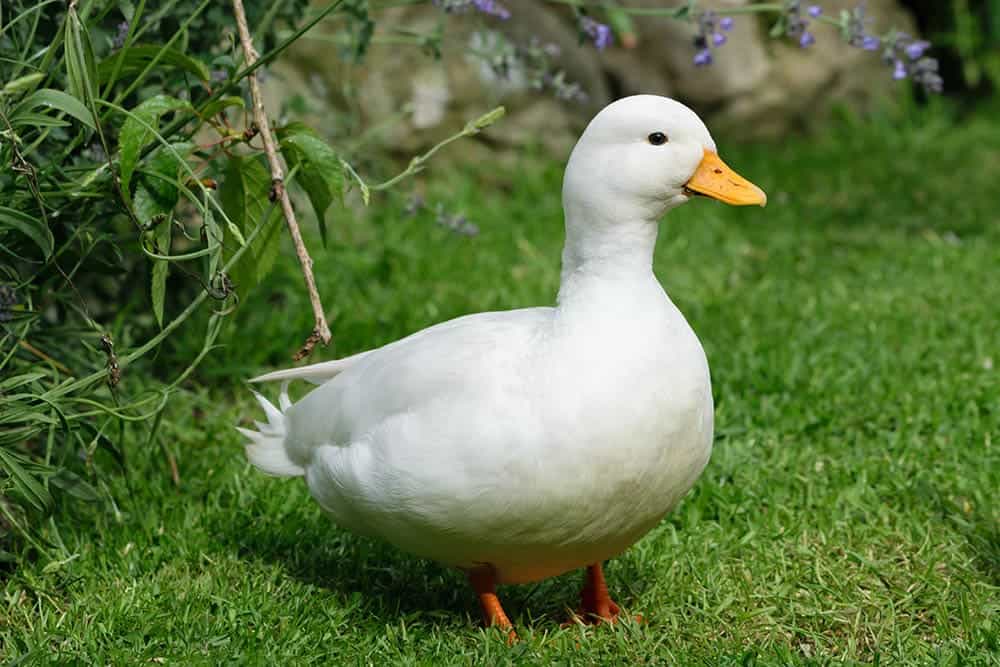
Call ducks look like Pekin ducks but smaller. They do well in cold weather as adults. Call ducklings need to be kept warm.
Call ducks weigh less than 2 pounds and are typically kept as pets and for show purposes. They are also noisy, with a surprisingly high-pitched, loud call. They were originally used by hunters because their calls would lure wild ducks near them. Call ducks have since been replaced by artificial duck calls.
They lay eggs through the winter and can produce up to 150 per year. These eggs are smaller than average due to the duck’s size and weigh around 1.5 ounces each.
7. Blue Swedish

Blue Swedish ducks are medium-sized with light blue bodies and white bibs. They’re dual-purpose birds that can lay up to 150 eggs per year. They are considered one of the hardiest cold weather duck breeds, tolerating all climates. They have body shapes similar to Pekin ducks.
These ducks are friendly and docile, so they make good pets. They are noisy, however. Their quack sounds like a loud yell. Blue Swedish ducks also like to forage and tend to not do well in confinement. If you have space for them to roam, they are an ideal choice for colder climates.
8. Silver Appleyard

The Silver Appleyard is a British dual-purpose breed of duck. They are large, sturdy birds. Males have greenish-black heads. They have brownish-red feathers splashed with white across their chests. Their bellies are white. Females are gray, cream, brown, or buff, with spots of dark brown feathers all over their bodies.
Silver Appleyard ducks weigh 7–10 pounds, adding to their ability to tolerate the cold. They can lay 250 eggs per year and will continue to produce them through the winter. If their needs are adequately met, these ducks can tolerate most weather conditions. Appleyard ducks like to forage and require space to do so. However, if they’re well-fed, they tend not to stray far.
9. Khaki Campbell
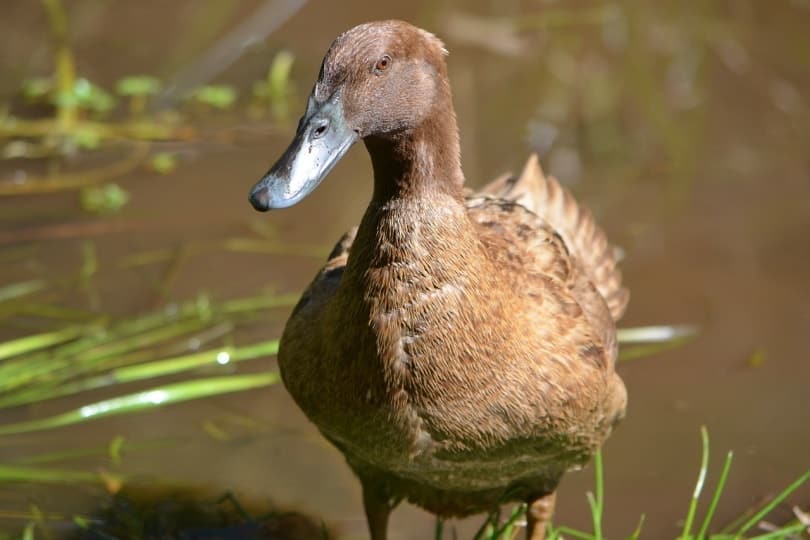
Khaki Campbell ducks are mostly kept for egg production. They can produce over 300 eggs per year! They are a hardy breed that continues to lay eggs throughout the winter. They can survive cold and hot temperatures, seemingly being unaffected by either.
These ducks are aptly named because of their khaki color. The males have olive-green heads. They resemble Mallards but lack the white banding around the neck. Khaki Campbell ducks are quiet birds that get along well with others in a flock.
10. Rouen
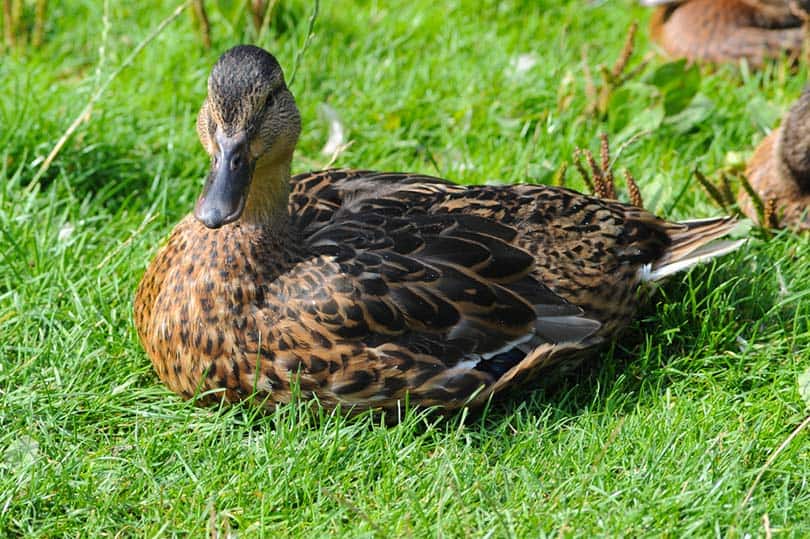
Rouen ducks are primarily raised for meat, which is described as lean and flavorful. They weigh between 6 and 12 pounds and can produce up to 125 eggs per year. Due to their colors and friendly temperaments, people choose to keep Rouen ducks as pets. They are hardy birds that can tolerate cold weather. If they have shelter from the wind in the winter and water to cool off during the summer months, they will be happy.
Females have brown bodies and light brown heads. Males are more colorful, with green heads and gray bodies. Both males and females have blue wing feathers.
11. Saxony

Saxony ducks are beautiful, cold-hardy, dual-purpose birds. They can lay up to 240 eggs per year. They can be noisy and active, but they do well in a flock. Females are a light peach color with grey and white markings. They have white markings around their eyes. Males have light grey heads, white bands around their necks, reddish-brown chests, and white bellies.
These ducks weigh 7–8 pounds. They’re gentle birds that make fun pets.
12. Orpington
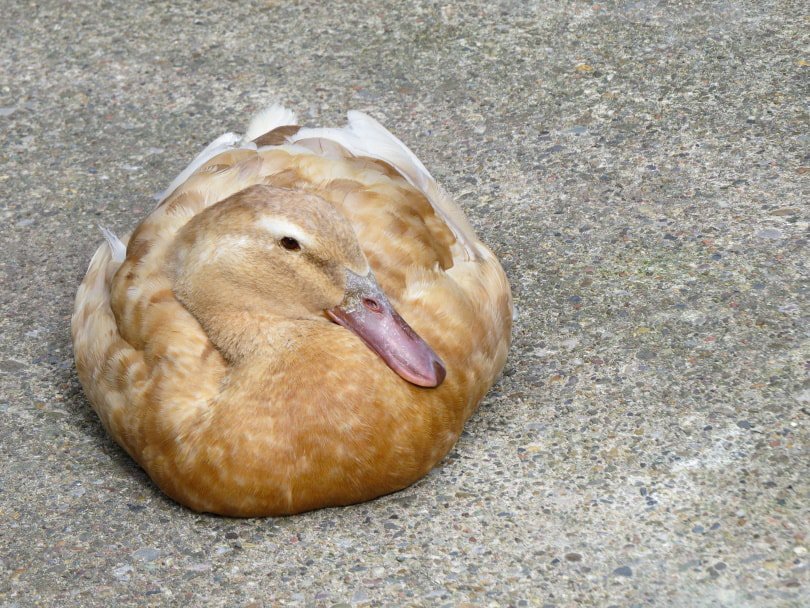
Orpington ducks are kept as pets but can also be used for eggs and meat. They produce up to 245 eggs per year. They are friendly, smart, and social. They can tolerate cold and heat well, provided that they have sufficient shelter during winter and enough water to swim in during warm months.
Orpington ducks weigh 6–8 pounds and tend to gain weight quickly. This is desirable if they are being raised for meat. They have buff-colored plumage and their tails are characteristically curled. Males have yellow bills. These are orange or brown on females.
 How to Tell if Ducks Are Cold
How to Tell if Ducks Are Cold
While ducks are hardy birds, they can still get cold. Here are a few signs to watch for that will let you know that your flock is too cold.
Less Active
Ducks enjoy being active year-round because cold weather doesn’t bother them. If they are always seeking out warm places or are less active than normal, consider bringing them inside.
Lying Down
If you’ve seen ducks walking around on snow and ice, you may have wondered how their feet don’t freeze. After all, they aren’t protected by feathers or body fat.
There is a netlike pattern of arteries in a duck’s legs called Rete Mirabile. This keeps blood pumping through their feet and legs to keep them from freezing. This system also cools the blood that is carried down to the feet so the birds don’t lose more heat than necessary.
If you notice your ducks lying down to cover their feet with their feathers, their bodies may not be able to keep up with warming them. Cold feet mean your ducks are cold too.
Huddling
Ducks tend to huddle together in cold weather for body warmth. This is a common occurrence, but it shouldn’t be the only thing that they do. If you notice that your ducks aren’t moving from the huddled group and are staying mostly inactive, they are too cold.
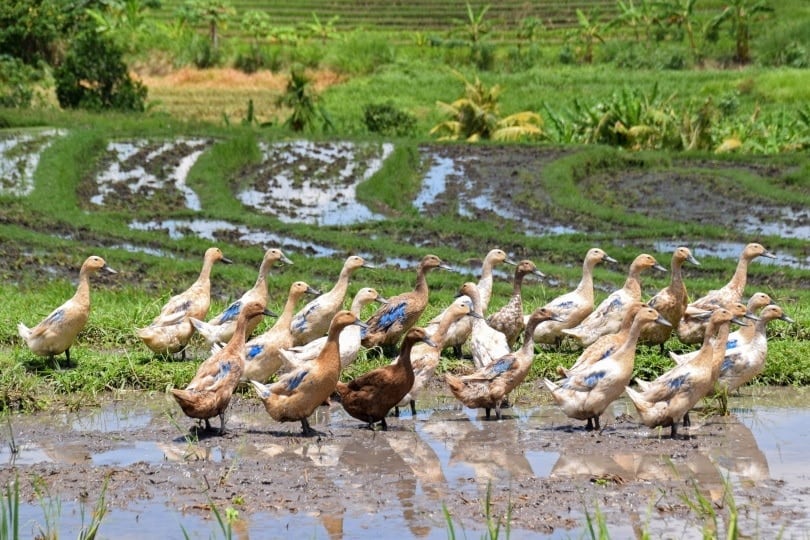
How to Help Ducks Stay Warm
Most ducks can do just fine in cold weather, but there are a few things that you can do to help them stay happy and healthy when winter arrives.
Straw
Straw is the preferred source of bedding for homesteaders because it insulates, doesn’t freeze, and will keep your ducks warm. Additional straw bales can be used along the walls of the coops or shelters to provide extra insulation. Ducks can snuggle down in a bed of straw and remain comfortable in cold weather.
Straw strewn about on the ground outside provides an insulating layer between your ducks’ feet and the cold ground. This can help your ducks regulate their body temperatures.
Make a Wind Barrier
Blocking the wind is important for ducks that like to be outside on cold days. In the wild, they can find shelter. In your backyard, you can make a shelter for them.
Block the walls of the outdoor pen with a tarp or pieces of plywood so your ducks can remain outdoors and not be in the constant path of the wind.
Don’t Forget the Water
Ducks need clean fresh water—even in the winter. To keep the water from freezing, invest in a heated bowl. Heated baths are also available to give your ducks a chance to hop in to bathe and go for a quick swim.
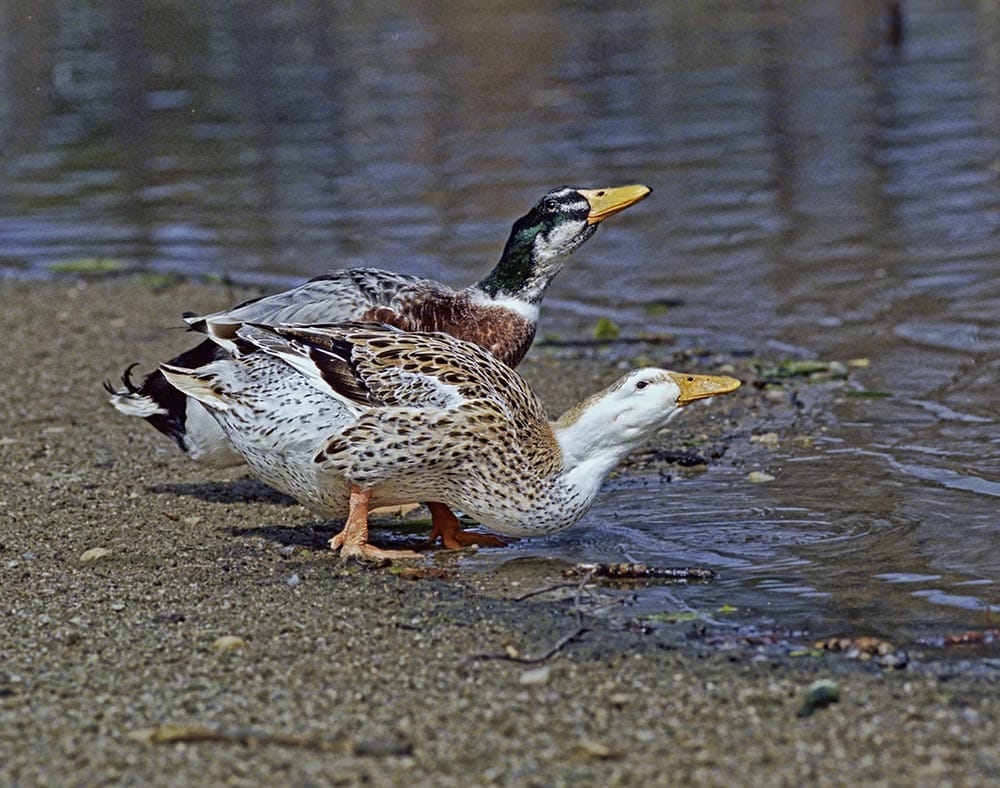
 Conclusion
Conclusion
Most duck breeds are suited to tolerate cold weather. Some do better in the bitter cold than others, though. While they are hardy birds, you can help them stay warmer in the winter by providing straw bedding, insulation, and wind barriers.
If you’re willing to put in the extra work to keep them comfortable in the winter, your ducks will reward you all year long.
Featured Image Credit: Alexas_Fotos, Pixabay
